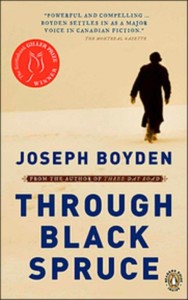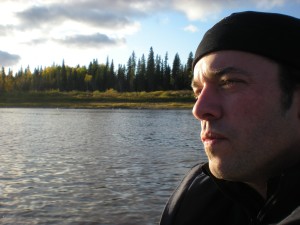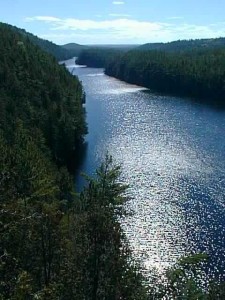Joseph Boyden – ‘Through Black Spruce’ and Inspiration
BIG Story
Joseph Boyden – His Inspiration – NE Ontario – ‘Through Black Spruce’
“Sit” “Magic” and “Me” Locations in NE Ontario
Where and Why Visitors Visit Their “BIG” Thoughtful Spots
by Back Roads Bill
(Editor’s note. Joseph Boyden, the award-winning author whose work vividly documents the complexity of Canada’s indigenous history, is among the recent latest appointments to the Order of Canada. Just before the announcement Back Roads Bill, through Penguin Random House Canada, was able to interview the Giller Prize Winner and about “thoughtful places” – the location for his ongoing inspiration.)
Winnie the Pooh. His reflective location was a log under a tree marked by a sign that read, “Pooh’s thotful spot.” It was the place where Pooh did his best thinking. It was where he got his inspiration when his well ran dry.
Often when Pooh visits his thoughtful spot, he sits down, taps his head, closes one eye, and says, “Think, think, think.” That is a sign that he is thinking hard.
Visitors journey to northeastern Ontario for many “BIG “reasons in all four seasons. These “thoughtful places” we seek are often called, “me,” “magic” of “sit” spots. Sought after locations, for times of solitude in the natural world. We often sharpen nonverbal skills like watching and waiting, silencing and stilling, opening and receiving and reflecting on one’s life in the moment.
Water and land trails lead us to favourite vistas and waterfalls all providing solace and comfort, with the next visit. What about a famous author, where does he go for inspiration? Of course it is northeastern Ontario!
Boyden – ‘Through Black Spruce’
Joseph Boyden’s first novel, ‘Three Day Road,’ won numerous awards including the Rogers Writers’ Trust Fiction Prize and the McNally Robinson Aboriginal Book of the Year. His second novel, ‘Through Black Spruce,’ was awarded the Scotiabank Giller Prize and named the Canadian Booksellers Association Book of the Year; it also earned him the CBA’s Author of the Year Award. Completing the triology to date (two more novels on the way) ‘The Orenda’ was a finalist for the Governor General’s English Language Prize and the Scotiabank Giller Award, and won the Libris Book of the Year Award. In 2012, Boyden received the Queen Elizabeth II Diamond Jubilee Medal for his contributions to Canadian art and culture. Boyden is a member of the creative writing faculty at the University of British Columbia in Vancouver, Canada, and at the Institute of American Indian Arts in Santa Fe, New Mexico. He divides his time between Northern Ontario and Louisiana.

‘Giller Prize’ Recepient
We know the setting for ‘Through Black Spruce’ is Moosonee. The small town located along the Moose river and about 19 kilometers away from James Bay. It is known as “The Gateway to the Arctic.” In the book it is described as the end of the tracks, an isolated town where just through the black spruce another world lies. There are two main characters with parallel stories. The two settings featured are seemingly incongruous: the hunting and trapping centered life in Northern Ontario and the fashion model scene in Montreal and New York City.
Setting plays a major role in the story because it acts as a place of respite for Annie as she journeys down south and a place to avoid for Will. The two main characters have completely opposite view on Moosonee. Will lives a few kilomotres away from the town out in the bush. There, where other people view as dangerous Will views as safe. He thinks that the real danger lurks in the city.
Annie constantly thinks back to her town when she is in New York, Toronto and Montreal. The town of Moosonee is not as bad as the towns she visited and therefore she has a different view of it. She associates the town with all the good, such as her family, friends, the beauty of the land and good things it provides. Will only sees it for the bad and believes that the bush will provide everything for him.
He said, “Some of what I consider my most important epiphanies as a writer were experienced here. I write primarily from the point of view of First Nations, of which I am a part. My writing didn’t really mature until I reconnected with the land in a big way in the mid-1990s, and from there I’ve constantly been amazed and hugely appreciative to recognize how humans are just one small part of the bigger landscape.
“Having lived on the west coast of James Bay, travelling from Moosonee north to reserves like Fort Albany, Kashechewan, Attawapiskat and as far as Peawanuck by Hudson Bay, I fell in love with both the land and the people. I’d never seen such a beautiful, rugged, and sometimes terrifying landscape. And I’d never met a more generous and life-loving people. The landscape and the people are inseparable, and I realized I had found my writing home, my writing heart. I continue strong friendships there, and still travel up the four seasons to camp, canoe, fish, hunt and snowmobile.”

Joseph on the Abitibi River – His Inspiration
Boyden said, “As for specific places of inspiration, Moose Factory is just a freighter canoe trip in summer or a short snowmobile ride in winter, but it feels so absolutely different than its cousin Moosonee across the Moose River. Reserve life is a more contained life, a richer life in some ways. Despite what we so often and wrongly hear, living on a reserve is living in independence and self-reliance. The people of Moose Factory are rightfully proud of their beautiful community and the the spirit is both friendly and foreign to outsiders. I love that and it has given me a lot of fodder for my fiction over the years.”
The writer acknowledges another. “I’m also lucky enough to call the Cree legend (trapper, hunter, and former bush pilot) William Tozer one of my best friends. He’s introduced me to the land of James Bay, and the land itself I think is the heart of my writing. I’ve gone onto the land with William for twenty years now, and every time I do, he teaches me something new. The land of Mushkegowuk is certainly gorgeous, but it isn’t a place to be overly romantic about. The bush can just as easily kill you as sustain you, and I think that’s the most important lesson I’ve been taught.”
So where is this bush? His current destination for inspiration and solace is a camp called Onakawana that introduces indigenous youth to the land, to their birthright.
Joseph extends an invitation to visit. “If you ever wish to reach our Camp Onakawana, drive to Cochrane, and then board the Polar Bear Express. Make sure to ask the conductor to stop the train at the 131.5 mile marker, where the tracks cross the Onakawana River and then walk in on the trail the few kilometers to the camp.” The confluence is located on the Abitibi River downstream from the Little Abitibi River (WGS 84 N50° 39.892’ W81° 21.679’ or 17 U 474465 5612620.) (For many canoeists it is on the canoe route from Abitibi Canyon, north of Smooth Rock Falls, northeast, downstream on the Abitibi River to the James Bay coast to Moose Factory and Moosonee. On the way you could visit a former the Hudson Bay Co. outpost and New Post Falls, one of my favourite locations in northeastern Ontario.)
Thoughtful Places – Tips

Mattawa Vista – BRBill “me” spot
Back Roads Bill shares a “me” location; seldom seen, it is the vista at Elm Point on the north side of Mattawa River, just east of aboriginal ochre mine. It is a short walk from the sand beach up the slope along the east side of the cold water stream, to the highest contour; walk east about 400 m. The view along the Mattawa fault line seems to go on forever, (WGS 84 N46° 18.307’ W78° 56.347’ 17 T 658644 5129962).
It allows me to hear the wind in the red and white pines. It allows for an unobstructed view of nature with no development in sight or unnatural sounds. It is a multi-sensory location. The location reflects my long-time thoughts of being “with” nature. The conjunction is inclusive, rather than exclusive and many metaphors can be drawn as to how we – as a human species – relate to the natural world. Sitting on the precipice “grounds me.” Any time of the year I will venture here, with snowshoes soon enough.
Relax in your “magic spot” for at least 5-10 minutes or as long as you like (don’t time it…you will know when you are ready to leave). Pay attention to “things” on the micro-scale (ie. what is located directly in front of you) and “things” on the macro-scale (ie. the BIG picture). Try not to think too much (I know this can be hard)…about the why’s and explanations for things but rather to enjoy and “see” and “hear” (perhaps for the first time) the beauty and features of our natural world.
Look for a spot where you will be left alone. You need time and space where you can watch, but people won’t interrupt the conversation in your head. Find a place that sparks your imagination a place to call your own. When you arrive, turn off your phone. It is a guarantee the electronic appendage will ring right as inspiration begins to unload. Take that “me” time and think for yourself. You won’t have to tap your head.
